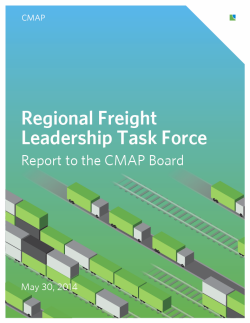Major Metros Freight Principles
In February 2014, CMAP and other major metro organizations co-signed a letter that calls on the federal government to establish a "Freight Trust Fund" and to integrate metropolitan regions in the freight decision-making process. Read into the Senate Committee on Environment and Public Works record by its chairman, Senator Barbara Boxer, the letter recommends the following as Congress develops a transportation reauthorization bill to replace the Moving Ahead for Progress in the 21st Century (MAP-21) Act, which expired in September 2014 and has since been extended through October 29, 2015:
- Integrating metropolitan regions into the freight investment decision-making process.
- Dedicating a range of funding sources and authorizing a minimum of $2 billion funding per year for freight investments, consistent with proposals from national freight advocacy organizations.
- Redefining the national freight network to comprise a multimodal transportation system
Commenting on the Draft Primary Freight Network
MAP-21 charges the U.S. Department of Transportation (U.S. DOT) with establishing a National Freight Network composed of three parts: (1) a Primary Freight Network, (2) critical rural freight corridors, and (3) components of the Interstate highway system not included in the Primary Freight Network. The Primary Freight Network (PFN) will feature the 27,000 centerline miles of existing roadways that are most essential to freight movement. It is within U.S. DOT's discretion to designate a further 3,000 miles of existing and future un-built roadways under the Primary Freight Network.
Pursuant to MAP-21, in November 2013 the Federal Highway Administration released a draft PFN for public comment. While a first attempt to designate a limited number of miles using multiple selection factors, the draft PFN tended to underrepresent the importance of freight movement within metropolitan areas. CMAP commented on the draft PFN in two ways:
- Major metro organizations. Working with the same group that developed the freight policy principles described above, CMAP submitted comments from the perspective of major metropolitan planning organizations.
- Northeastern Illinois. Working with regional partners, CMAP submitted detailed comments focused on the draft PFN in northeastern Illinois. These comments included both policy recommendations as well as specific suggestions to add, delete, or modify components of the draft PFN in the Chicago region.
